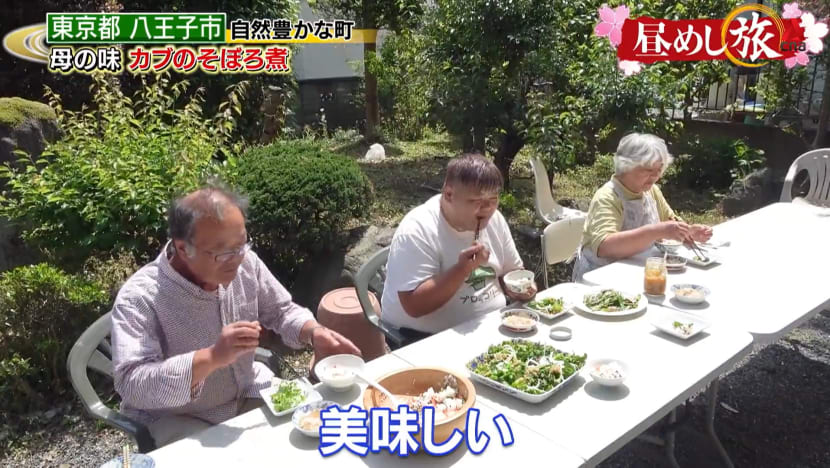It's Lunchtime - Chiba Prefecture
This week's highlights include a butcher shop by the ocean which sells Kagoshima's famous black pork, a farm growing mainly summer leeks and another which boasts more than 100 kinds of vegetables.

Our culinary tour to find out what people eat in different towns and cities continues. The first place we go to is Ichinomiya Town in Chiba Prefecture. It is located on the south side of Kujukuri Beach. We start by visiting a butcher shop near the ocean, called Genki Meat. It is owned by Mr Uchida, who will ask his customers what kind of dish they want to make and then select the best meat for it. Many people come here on holidays to buy meat for barbecues.
He shows us how to cook his favourite black pork steak and Hamburg steak. Black pork from Kagoshima is flavourful with fine fibres, which make the meat very tender. Mr Uchida selects shoulder meat for the pork steak. The thickly sliced meat is vacuum packed and cooked at a low temperature. It is seasoned with salt and pepper and cooked on both sides in a frying pan until browned. The meat is then wrapped in aluminium foil to let the remaining heat cook the meat. This way, the pork steak will turn out tender and juicy. Hamburg steak made with Kagoshima black pork thigh meat is also popular.
Mr Uchida agrees to show us his lunch. He makes a Japanese-style pasta with grated daikon and black pork sausages. At the age of 18, Mr Uchida got his first job as a cook in a pasta restaurant in Shimokitazawa. This pasta dish was the restaurant’s most popular item. He chops coarse-ground sausages made with Kagoshima black pork and cooks them in a frying pan. He puts butter in a bowl and adds freshly cooked pasta. He then adds granulated kelp broth and olive oil and mixes the noodles. He tops the noodles with grated daikon and pours some soy sauce. He finally adds the sausages and puts lots of shredded seaweed and some perilla leaves. As a side dish, he makes oat milk and black pork soup. It consists of onions, Kagoshima black pork ham, milk made from oats and snap peas. The soup is seasoned with just salt and pepper.
Our next stop is a farm in Ichinomiya, where we meet Mr Makoto Machi. He grows premium summer leeks from Chiba Prefecture. They are a seasonal speciality of the Kujukuri coast and are only harvested in May. They are known for being juicy, soft and sweet. The field has about 20,000 leeks and he harvests 2,000 of them by himself daily. The harvested leeks are brought home and prepared for shipping. He uses a machine to cut the roots and tips of the leaves, and then the skin is peeled off. The leeks are shipped to different places, including local farmers’ markets.
Previously a firefighter in Tokyo, Mr Machi has been a farmer for five years, with 15 vegetable fields. He discovered the joy of growing vegetables after a farm experience, where he learnt about planting and harvesting rice. So at the age of 41, he moved to Ichinomiya and became a farmer. For his lunch, he makes leek and salted fried noodles with homegrown vegetables. He uses vegetables from his farm, such as onions, cabbage and peas. His meal also includes charcoal-grilled leeks.
The next place we go to is Hachioji City in Tokyo. We visit the Sakamoto Farm and meet Mr Takashi Sakamoto and his father Chiaki. Mr Takashi, who used to work in a company, took over the farming business about seven years ago. The family grows vegetables according to requests from different restaurants. For example, they will grow different kinds of tomatoes to cater to their customers’ needs. Local restaurants heard their vegetables are good so they started placing orders. Now, more than 100 types of vegetables are grown at the farm. Another seasonal vegetable they grow is “France Endo” green peas, which are used for stir-frying or miso soup. The vegetables are picked in the morning and delivered before noon. They also deliver vegetables to people's homes.
They agree to let us see their meal, so we go to their house. We meet Mr Takashi’s mother, Noriko, who will cook lunch for the family. She uses freshly picked vegetables like broccoli, purple mizuna and snap peas to make a salad. She then stir-fries Franco Endo peas with bacon. Other dishes include turnips simmered with minced chicken and rice mixed with salmon and perilla seeds.
Mr Takashi then takes us to his client’s restaurant to check out the meals. Asian Bar Soi J is owned by Junji Nagasawa, known as J. Opened three years ago, the restaurant serves Southeast Asian dishes, mainly Thai cuisine. Its popular items include Khao Man Gai, Tom Yum Kung and other authentic Thai dishes. Before starting his restaurant, J worked at several Southeast Asian restaurants for more than 10 years. He also went to Thailand to learn authentic cooking.
For lunch, J uses vegetables from the Sakamoto Farm. He makes Thai basil stir-fried with aubergines, France Endo peas and minced pork. He adds a Thai chilli paste made with onions, dried shrimps and chilli peppers. The dish also includes paprika, chicken broth and a homemade oyster sauce.
For his employees’ lunch, J makes a spicy Thai curry called Kaeng Pa. It is on the restaurant’s “secret menu”, where it is only prepared if a customer asks for it. It includes broccoli, Thai curry paste made of chillies, lemongrass and other herbs ground in a mortar, stir-fried pork shoulder meat, radish, aubergines, chicken broth, finely chopped Thai ginger, kaffir lime leaves and Thai basil.
Tips:
1) Black pork is a speciality of Kagoshima
2) Summer leeks are a must-try item when visiting the Kujukuri coast in Chiba












